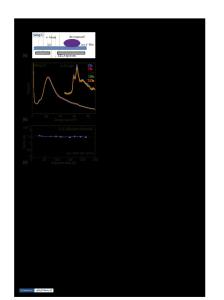An in situ transmission electron microscope investigation into grain growth and ordering of sputter-deposited nanocrysta
- PDF / 402,393 Bytes
- 10 Pages / 612 x 792 pts (letter) Page_size
- 14 Downloads / 443 Views
The grain growth kinetics and ordering behavior of direct-current magnetron sputter-deposited Ni75at.%Al25at.% alloy films were investigated using in situ isothermal annealing in a transmission electron microscope. Both normal and abnormal grain growth modes were observed. The normal grain growth kinetics under isothermal . heating from 300 to 700 °C were found to comply with the Burke law d ⳱ K/d n−1, where d is grain size and K and n are constants with respect to time. The grain boundary mobility parameter K was found to obey an Arrehnius rate law with an apparent activation energy of 1.6 eV, and n was found to increase gradually from 5.2 at 300 °C to 8.7 at 700 °C. Abnormal grain growth occurred at 500 °C or higher, and grain coalescence was identified as an important operative mechanism. It was also observed that the initially as-deposited state of the films was crystalline with a disordered face-centered-cubic structure, but ordering into the equilibrium L12 intermetallic structure followed from annealing at temperatures above approximately 500 °C. I. INTRODUCTION
Intermetallic films are being actively investigated for potential use as functional coatings for engineering applications ranging from aeroengines to microelectronic devices. Numerous studies have been dedicated to intermetallic aluminide coatings in the last few years, with substantial attention paid to the mechanical properties and high temperature oxidation resistance of Fe–Al, Ni–Al, and Ti–Al-based coatings.1–7 For instance, the present authors and Xu et al. have reported that Ni3Al coatings can provide Ni-based alloys with significantly improved surface strength,3,4 as well as effective protection from thermal oxidation.3 Similarly, Leyens et al. showed that Ti–Al-based coatings exhibit a variety of beneficial properties on the oxidation, creep, and fatigue of TIMETAL 1100 high temperature alloys.5,6,8 On the other hand, the metallization of semiconductors by intermetallic aluminides like Ni–Al and Ti–Al as interconnects represents a growing field of interest in the microelectronic industry.9–11 In a recent paper, we demonstrated that direct-current (dc) magnetron sputter-deposited Ni75at.%Al25at.% thin films exhibit a phenomenal electrical transition from an insulating state to a conducting state upon mild heating.12 a)
Present address: Laboratoire des Mate´riaux et du Ge´nie Physique, ENSPG-INPG UM 5628, BP 46, 38402, St. Martin d’He`res, France. J. Mater. Res., Vol. 17, No. 8, Aug 2002
http://journals.cambridge.org
Downloaded: 22 Mar 2015
The transition effect is found to be reversible with respect to temperature changes, implying that the transition happens at constant microstructure. This is to be distinguished from another effect of electrical resistance variation due to annealing of the film’s microstructures. The as-deposited state of the Ni75at.%Al25at.% films is known to be nanocrystalline with a typical grain size of the order of a few nanometers.12,13 Such a refined nanocrystalline configuration, together with a significant oxyge
Data Loading...











